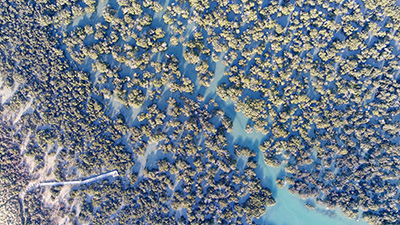Native Plant Conservation Campaign News: Native plant communities "bend but do not break" during severe storms and floods, protect lives and property
June 7, 2019
 New Scientific American Article IN BRIEF:
New Scientific American Article IN BRIEF:- Surprising data show that marshes can protect shorelines better than walls and are cheaper to construct.
- Scientists are perfecting techniques for rebuilding tattered wetlands, creating custom configurations for individual shorelines.
- Governments and disaster planners are starting to give more consideration to living shorelines, and money to restore them is rising.
NPCC works to educate the public and policymakers about the invaluable Ecosystem Services delivered by native plant communities.
Nature Based Solutions is the use of conservation and restoration of native plant communities and Ecosystem Services to confront climate change, severe storms, and other threats to people and the planet, and in general to make communities more safe, prosperous and resilient.
A new Scientific American article reports on new studies which review the effectiveness of Nature Based Solutions in protecting coastlines during hurricanes and other storms. The article also discusses the growing number of communities turning to these initiatives to shield them during these events.
One study compared how coastal native plant communities and concrete bulkheads protected shorelines and property during Hurricane Irene, which  destroyed 1,100 homes in North Carolina in 2011. While three quarters of coastal concrete storm walls were damaged by Irene, “none of the natural marsh shorelines were impaired. The marshes, … had lost no sediment or elevation. Although the storm initially reduced the density of their vegetation by more than a third, a year later the greenery had bounced back and was as thick as ever in many cases.”
destroyed 1,100 homes in North Carolina in 2011. While three quarters of coastal concrete storm walls were damaged by Irene, “none of the natural marsh shorelines were impaired. The marshes, … had lost no sediment or elevation. Although the storm initially reduced the density of their vegetation by more than a third, a year later the greenery had bounced back and was as thick as ever in many cases.”
 destroyed 1,100 homes in North Carolina in 2011. While three quarters of coastal concrete storm walls were damaged by Irene, “none of the natural marsh shorelines were impaired. The marshes, … had lost no sediment or elevation. Although the storm initially reduced the density of their vegetation by more than a third, a year later the greenery had bounced back and was as thick as ever in many cases.”
destroyed 1,100 homes in North Carolina in 2011. While three quarters of coastal concrete storm walls were damaged by Irene, “none of the natural marsh shorelines were impaired. The marshes, … had lost no sediment or elevation. Although the storm initially reduced the density of their vegetation by more than a third, a year later the greenery had bounced back and was as thick as ever in many cases.”In a related study, researchers reported that the 37 percent of properties protected by concrete had suffered 93 percent of the damage during Irene. Further, annual cost of bulkhead maintenance was found to be four times that of conserving and restoring natural shorelines.
This information is important because as climate change and severe storms and flooding accelerate, coasts are increasingly being lost to erosion. Every day, approximately 89 hectares worth $500 million disappear.
Such economic impacts have led to collaborations between scientists and the insurance industry. For example, researchers examined the effect of wetlands during Hurricane Sandy in 2016. Among their findings:
- salt marshes and mangroves, with their dense forests of stalks, could buffer more than 50 percent of the energy from storm surges
- wetlands prevented $625 million of flood damage from Sandy, even though the coasts in the region had lost 60 to 90 percent of their protective wetlands.
- In areas that flooded, the few remaining wetlands lowered flood damage by 11 percent on average.
- properties behind marshes suffered 16 percent less annual flood damage than properties that had lost their marshes.
These discoveries are inspiring new Nature Based Solutions policies and projects around the U.S. and around the world. According to the article, “The Army Corps [of Engineers], which for decades has favored hardscape solutions, has launched an Engineering With Nature initiative…. The National Oceanic and Atmospheric Administration has made living shorelines a centerpiece of its coastal-resilience blueprint. Hundreds of projects have been completed or are underway around the country…” Further the Living Shorelines Act was introduced in the U.S. House and Senate in 2018. The bill would designate $20 million in annual grants a year for living-shoreline work.
The article also reviews case studies that illustrate how Nature Based Solutions projects can succeed and fail, and surveyed research exploring various approaches to coastal flood and erosion protection.
Read the full article at Scientific American
Learn more about Ecosystem Services and Nature Based Solutions on the NPCC website
NPCC has developed a slide show on Nature Based Solutions. View it online.
If you would like to schedule a presentation on native plants and Nature Based Solutions, let us know!
Photos:
Mangroves at high water (c) Mangrove Action Project
Slide from NPCC Nature Based Solutions presentation (c) Native Plant Conservation Campaign